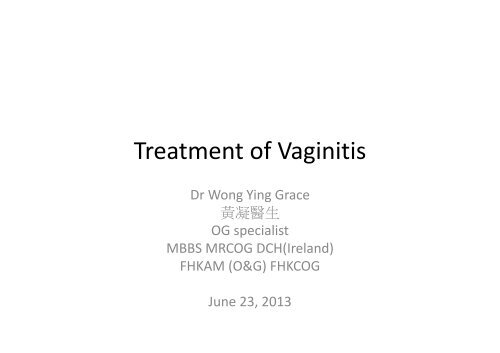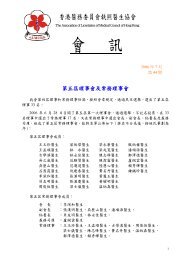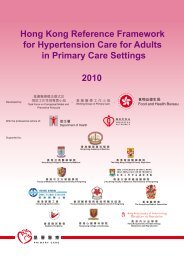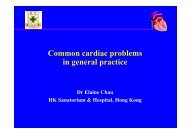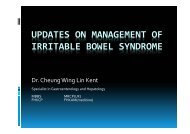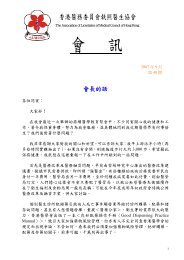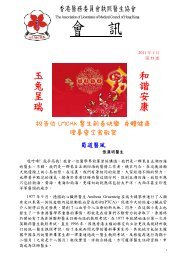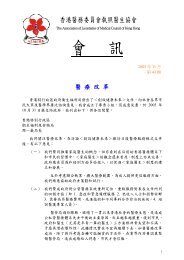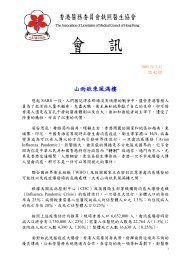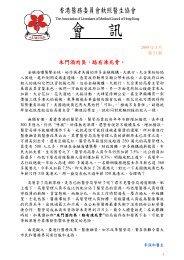Treatment of Vaginitis
Treatment of Vaginitis
Treatment of Vaginitis
- No tags were found...
Create successful ePaper yourself
Turn your PDF publications into a flip-book with our unique Google optimized e-Paper software.
<strong>Treatment</strong> <strong>of</strong> <strong>Vaginitis</strong>Dr Wong Ying Grace黃 凝 醫 生OG specialistMBBS MRCOG DCH(Ireland)FHKAM (O&G) FHKCOGJune 23, 2013
Diseases characterized by vaginal dischargeCareful historySexual behaviorsGender <strong>of</strong> sex partnersMensesVaginal hygiene practices (douching)Other medications
3 diseases most frequently associatedwith vaginal discharge1. Bacterial Vaginosis 細 菌 性 陰 道 炎2. Trichomoniasis 陰 道 滴 蟲3. Candidiasis Albicans 念 珠 菌
Bacterial vaginosis 細 菌 性 陰 道 炎陰 道 内 正 常 菌 群 失 調 所 致 , 陰 道 内 有 大 量 的細 菌 、 伴 有 陰 道 分 泌 物 性 質 改 變 的 一 組 症 候群Lactobacillus ( pH)Mixed growth <strong>of</strong> anaerobic bacteria(bacterial floral imbalance)
Bacterial Vaginosis 細 菌 性 陰 道 炎• BV is a polymicrobial clinical syndromerepresents a complex change in the vaginal floracharacterized by a reduction in concentration <strong>of</strong> thenormally dominant hydrogen‐peroxide producinglactobacilli, and an increase in the concentration <strong>of</strong>anaerobic Gram negative bacteriaeg Prevotella sp, Mobiluncus sp, Gardnerellavaginalis, Ureaplasma, Mycoplasma.
Bacterial vaginosis 細 菌 性 陰 道 炎• Loss <strong>of</strong> lactobacilli• pH rises• Massive overgrowth <strong>of</strong> vaginal anaerobes• These anaerobes produce large amounts <strong>of</strong>proteolytic carboxylase enzymes, which breakdown vaginal peptides into a variety <strong>of</strong> aminesthat are volatile, malodorous with vaginalsquamous cells exfoliation.
Bacterial Vaginosis (BV) 細 菌 性 陰 道 炎BV is the most prevalent cause <strong>of</strong> vaginal discharge ormalodor (CDC guideline 2010)• About 50 to 75 % <strong>of</strong> women with BV are symptomatic• When symptomatic, the symptoms are <strong>of</strong>f –white, thin,homogenous “fishy smelling” discharge which is morenoticeable after coitus and during menses• In US, National survey (self collected vaginal swabs <strong>of</strong> over3700 women) ‐ the prevalence <strong>of</strong> BV was 29 percent in thegeneral population <strong>of</strong> women aged 14 to 49 yo
Bacterial Vaginosis 細 菌 性 陰 道 炎• BV is associated with:1 having multiple sex partner2 a new sex partner3 Douching4 lack <strong>of</strong> condom5 lack <strong>of</strong> vaginal lactobacilli(most experts believe that BV does not occur inwomen who have never had vaginal intercourse)
Bacterial Vaginosis 細 菌 性 陰 道 炎• Women with BV are at increased risk:• 1 acquiring STD’s(HIV, gonorrhea, Chlamydia, HSV2)• 2 complications <strong>of</strong> pregnancy (pretermlabour)/gynaecological surgery
Bacterial VaginosisDiagnostic criteria:BV can be diagnosed• 1 by Gram stain: relative concentrations <strong>of</strong>lactobacilli vs Gram negative/Gramvariablerods and cocci and curved Gram‐negative rods• 2 by clinical criteria
Bacterial VaginosisClinical criteria (amsel criteria) –at least 3 criteriamust be present:1. homogenous thin grayish white discharge thatsmoothly coats the vaginal walls2. presence <strong>of</strong> clue cells(ie epithelial cells with borders obscured bysmall bacteria) on microscopic exam3. pH <strong>of</strong> vaginal fluid >4.54. A fishy odor <strong>of</strong> vaginal discharge before or afteraddition <strong>of</strong> 10% KOH (the whiff test)
Bacterial Vaginosis• DNA probe based test for high concentrations <strong>of</strong>Gardnerella vaginalis has been acceptable test.(CDC guideline ‐2010)• Pap smear is not reliable for diagnosis <strong>of</strong> BV• Vaginal culture has no role in diagnosis becauseBV reprsents complex changes in the vaginal flora.
Bacterial Vaginosis• <strong>Treatment</strong>• BV can resolve spontaneously in up to 1/3 <strong>of</strong>women.• Therefore, treatment is not necessary forasymtomatic women (CDC recommendation)• Aim is to relieve vaginal symptoms and reduce inthe risk for acquiring Chlamydia or Neisseria, HIVand other viral STD’s.
Bacterial VaginosisRecommended regimen:Metronidazole 500mg BD oral for 7 days(Consuming alcohol should be avoided during treatment and for 24 hours thereafter)Metronidazole gel 0.75%one full applicator 5 gram intravaginally once a dayfor 5 daysClindamycin cream 2% one full applicator 5 gram intravaginal at bedtime for 7daysAlternative regimen:Tinidazole 2 gram orally once daily for 2 daysOr Tinidazole 1 gram orally once daily for 5 daysOr Clindamycin 300mg oral twice daily for 7 days• (CDC guideline 2010)
Bacterial Vaginosis• Douching may increase the risk <strong>of</strong> relapse• Women should refrain from intercourse or usecondoms consistently during treatment period
Bacterial Vaginosis• Follow up visits are unnecessary if symptoms resolve• Recurrence <strong>of</strong> BV is common, so women should beadvised to return if symptoms recur• Monthly oral metronidazole administered withfluconazole has been evaluated as suppressive therapy.• Routine treatment <strong>of</strong> sex partner is not recommended
Bacterial Vaginosis• Special considerations• Allergy:• Intravaginal clindamycin cream is preferred incase <strong>of</strong> allergy or intolerance to metronidazoleor tinidazole.
Bacterial Vaginosis in pregnancy• ACOG and CDC recommends not to routinely screenand test all pregnant women with asymptomatic BV toprevent preterm birth.• There may be benefits to early screening andtreatment <strong>of</strong> asymptomatic pregnant women who haveprevious history <strong>of</strong> preterm delivery.• Recommended dose for pregnant women• Metronidazole 500mg BD oral for 7 days• Or 250mg oral three times daily for 7 days• Or Clindamycin 300mg oral BD for 7 days
Bacterial Vaginosis• Women undergoing pregnancy terminationwho have asymptomatic BV• ‐ should be given flagyl to prevent post‐opinfectious complications• (up to date 2013)
Bacterial Vaginosis• Use <strong>of</strong> probiotics (intravaginal lactobacillusformulations) to treat BV –no sufficientevidence for or against efficacy.
Trichomoniasis 陰 道 滴 蟲Men may not have symptoms, some may haveurethritisWomen have diffuse malodrous, yellow‐greendischarge with vulva irritation.Many women do not have symptomsDiagnosis‐ microscopy –wet preparation slides
Trichomoniasis• Culture test is sensitive and highly specificRecommended treatment• Metronidazole 2 gram orally in a single dose• Tinidazole 2 gram orally in single doseAlternative treatmentMetronidazole 500mg orally twice a day for 7 daysUse <strong>of</strong> metronidazole gel is not recommended becauseless efficacious
Trichomoniasis• High rate <strong>of</strong> reinfection.• Therefore rescreening for trichomoniasis at 3months following initial infection can beconsidered for sexually active women withtrichomoniasis (CDC guideline 2010)• Sexual partner should be treated
Trichomoniasis• Vaginal trichomoniasis has been associated withadverse pregnancy outcomespremature rupture <strong>of</strong> membranespreterm labour, low birth weight.• Women can be treated with 2 gram metronidazole in asingle dose at any stage <strong>of</strong> pregnancy.• Multiple studies and meta‐analyses have notdemonstrated an association between metronidazoleuse during pregnancy and teratogenic effects.
Trichomoniasis• Lactating women –if administermetronidazole, withhold breastfeed duringtreatment and for 12‐24 hours after the lastdose will reduce exposure <strong>of</strong> metronidazole toinfants.
Vulvocandidiasis 念 珠 菌• Candida Albicans• Pruritus vaginal soreness, beancurd likedischarge• Diagnosis –gram stain, wet preparation,culture
VulvocandidiasisClotrimazole cream, Butoconazole cream,miconazole cream, Ticonazole creamNystatin vaginal tablet 100,000unit one tablet 14daysTerconazole 80mg vaginal suppository onesuppository for 3 daysFluconazole 150mg oral tablet single doseItraconazole 200mg BD for a single day
Recurrent Vulvovaginal Candidiasis• Longer duration <strong>of</strong> initial therapy• E.g. 7‐14 days <strong>of</strong> topical therapy• or 100mg, 150mg, 200mg oral dose <strong>of</strong>fluconazole (Diflucan) every third day for atotal <strong>of</strong> 3 doses to attempt mycologicremission (CDC guideline 2000)
Recurrent Vulvovaginal Candidiasis• Oral fluconazole 100mg, 150mg or 200mgdose weekly for 6 months is the first line <strong>of</strong>treatment. (CDC guideline 2000)
Pregnant womenwith Vulval Candidiasis• Only topical therapies can be used
Vulval CandidiasisSporonox (itraconazole) 200mg BD poVsoral Fluconazole (Diflucan) 150mg QD po for onceSimilar efficacy• Itraconazole vs fluconazole for the treatment <strong>of</strong> uncomplicatedacute vaginal and vulvovaginal candidiasis in nonpregnant women:a metaanalysis <strong>of</strong> randomized controlled trials.• Pitsouni E, Iavazzo C, Falagas ME.• Am J Obstet Gynecol. 2008 Feb;198(2):153‐60.
Zalain ‐ sertraconazole• Safe to use. Effective• Drugs. 2009;69(3):339‐59. Sertaconazole: a review <strong>of</strong> its use in themanagement <strong>of</strong> superficial mycoses in dermatology and gynaecology.Croxtall JD, Plosker GL.
Conclusion• 1 Bacterial vaginosis, trichomoniasis and vulvovaginal candidiasis are themost common infectious causes <strong>of</strong> vaginitis.• 2. Bacterial vaginosis is a polymicrobial clinical syndrome resulting fromreplacement <strong>of</strong> lactobacillus in the vagina with high concentrations <strong>of</strong>anerobic bacteria.•• 3. Bacterial vaginosis is associated with having multiple sexual partners, anew sexual partner, vaginal douching and lack <strong>of</strong> condom use.•• 4. Women with bacterial vaginosis are at increased risk <strong>of</strong> acquiringsexually transmitted diseases, complications <strong>of</strong> pregnancy andcomplications after gynaecological surgery.•• 5. Women with trichomoniasis have symptoms characterized by a diffuse,malodorous, yellow‐green vaginal discharge.
Thank you
Management <strong>of</strong> PIDRCOG guideline 2008• Oral Ofloxacin 400mg BD daily +oralmetronidazole 400mg BD for 14 days• IM Ceftriaxone (Rocephin) 250mg single dose+oral doxycycline 100mg BD daily+metronidazole 400mg BD for 14 days
Management <strong>of</strong> acute PID• RCOG guideline 2008• Ceftrizxone 2g (Rocephin) by iv infusion plusIV doxycycline 100mg BD daily, followed byoral doxycyline 100mg BD and oralmetronidazole 400mg BD for a total <strong>of</strong> 14 days


